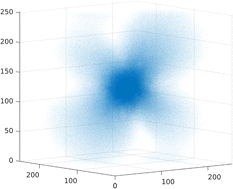Anomalous linear elasticity of disordered networks†
Abstract
Continuum elasticity is a powerful tool applicable in a broad range of physical systems and phenomena. Yet, understanding how and on what scales material disorder may lead to the breakdown of continuum elasticity is not fully understood. We show, based on recent theoretical developments and extensive numerical computations, that disordered elastic networks near a critical rigidity transition, such as strain-stiffened fibrous biopolymer networks that are abundant in living systems, reveal an anomalous long-range linear elastic response below a correlation length. This emergent anomalous elasticity, which is non-affine in nature, is shown to feature a qualitatively different multipole expansion structure compared to ordinary continuum elasticity, and a slower spatial decay of perturbations. The potential degree of universality of these results, their implications (e.g. for cell–cell communication through biological extracellular matrices) and open questions are briefly discussed.



 Please wait while we load your content...
Please wait while we load your content...